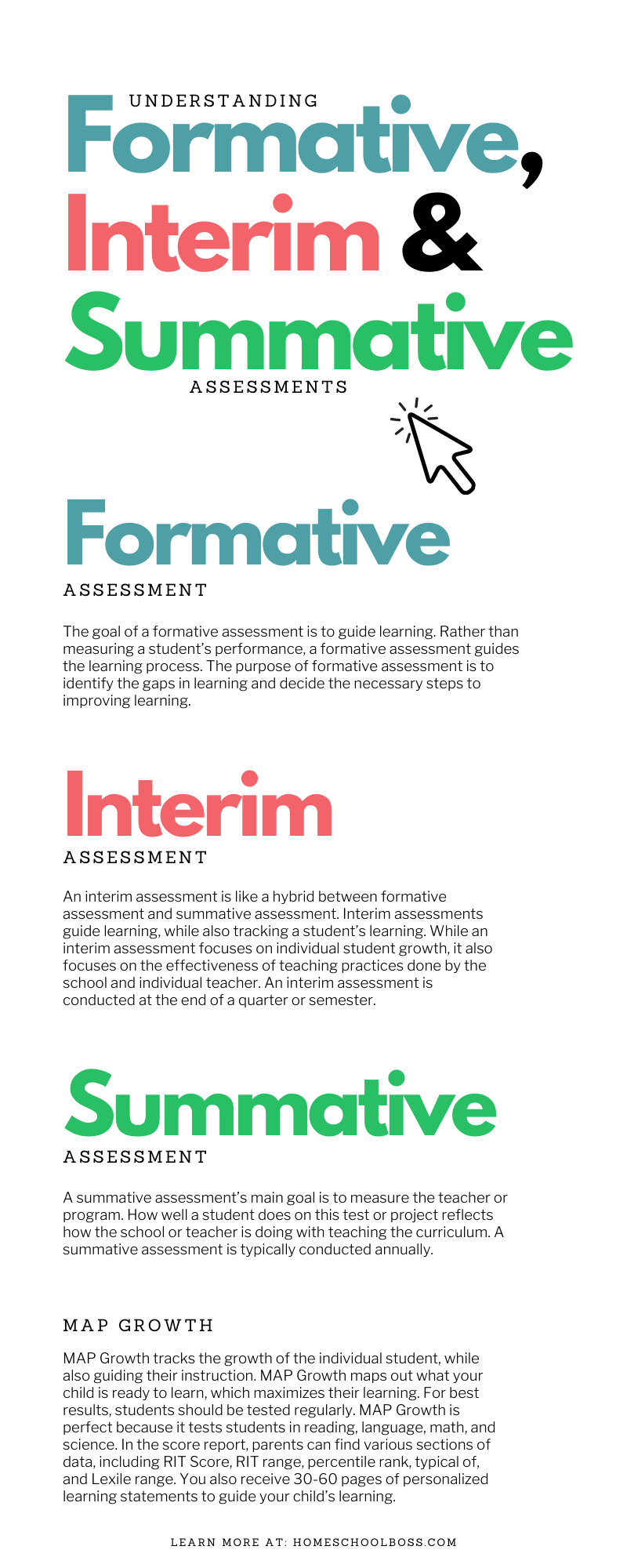Throughout the year, students are assessed in various ways. Whether it’s a test or a project, there are many ways to assess whether a student understands the curriculum. Assessments help measure how easily or clearly information is received by the students. Assessments are designed to maximize learning by clearly identifying what the student knows or has learned. An assessment benefits the student, teacher, and parent because it is a concrete way to measure a child’s understanding of the topics. Having these assessments is helpful because they identify what is working and what needs to be improved. Understanding formative, interim, and summative assessments can maximize the benefits of education, so keep reading to learn more.
Formative Assessment
Understanding formative, interim, and summative assessments is important because each has a different goal. The goal of a formative assessment is to guide learning. Rather than measuring a student’s performance, a formative assessment guides the learning process. Each assessment also measures something or someone different. In a formative assessment, the student is being measured. This kind of assessment measures the strengths and weaknesses of a student. This form of assessment also helps target areas that need improvement. This assessment gives educators an idea of how a student is learning. This assessment also aids educators in deciding strategies to improve the student’s learning. The purpose of formative assessment is to identify the gaps in learning and decide the necessary steps to improving learning.
A formative assessment is an ongoing assessment, meaning that it does not just occur once. These assessments tend to be low stakes, as they are meant to guide learning rather than evaluate it. This assessment can be in the form of an assignment or proposal, for example. The point of this assessment is to see how the student is doing with a specific unit or lesson. This assessment consists of many different strategies and can happen over time. These assessments tend to be more informal than other assessments. A formative assessment is meant to measure the student, rather than the school or teacher. This form of assessment allows students to set goals for their learning.
Interim Assessment
An interim assessment is like a formative assessment because both tools measure the student’s learning. An interim assessment is like a hybrid between formative assessment and summative assessment. Interim assessments guide learning, while also tracking a student’s learning. While an interim assessment focuses on individual student growth, it also focuses on the effectiveness of teaching practices done by the school and individual teacher. Interim assessments are a comparison of how the student is doing compared to standards met during the same school year. An interim assessment is conducted at the end of a quarter or semester. The results from the interim assessment help guide learning, so the results are often used for that current school year.
An interim assessment guides and tracks the individual growth of each student. Interim assessments are referred to as a hybrid between formative assessment and summative assessment because interim assessment also measures the effectiveness of teachers and programs. Interim assessments allow the instructor to evaluate the growth of the student, as well as guide their learning. Interim assessments can be developed by the school or bought commercially. One example of an interim assessment is the NWEA map test kindergarten through twelve.
Summative Assessment
Summative assessment is a comparison of the performance of the student to a set of standards. A summative assessment differs from the formative and interim assessment because a summative assessment’s main goal is to measure the environment of learning. To be more specific, a summative assessment’s main goal is to measure the teacher or program. How well a student does on this test or project reflects how the school or teacher is doing with teaching the curriculum. A summative assessment is typically conducted annually. To be more specific, this assessment usually comes at the end of the year or course.
A summative assessment measures the effectiveness of a program or school by measuring how well the student understands the curriculum. A summative assessment can take be a final project or paper, as well as an exam. This assessment can identify where a student needs improvement, but the main goal is to verify that the curriculum has everything it needs to make a student successful. The main goal is to evaluate the teaching or curriculum, which is why this assessment is typically administered at the end of the year. Summative assessments can guide teachers in assigning grades to students. Summative assessment is also used to evaluate the teachers. The federally administered end-of-year-tests are often what comes to mind when discussing summative assessment. Although this assessment can identify what a student has learned, the main goal is to evaluate education.
MAP Growth
Of the many forms of assessments, there is one assessment that is highly recommended for the wealth of information that it captures. NWEA’s MAP Growth test is an assessment that measures your child’s growth accurately, and it does so from the comfort of your home. MAP Growth is a form of interim assessment because it guides and tracks learning. MAP Growth tracks the growth of the individual student, while also guiding their instruction. MAP Growth maps out what your child is ready to learn, which maximizes their learning. For best results, students should be tested regularly.
MAP Growth is perfect because it tests students in reading, language, math, and science. MAP Growth is untimed and is conducted online, so students can take their time. After the student completes the MAP Growth assessment, parents receive a score report with a wealth of information that helps guide learning. On the score report, parents can find various sections of data, including RIT Score, RIT range, percentile rank, typical of, and Lexile range. You also receive 30-60 pages of personalized learning statements to guide your child’s learning.
The MAP Growth test makes it easy for homeschooling parents to assess their child’s learning. At Homeschool Boss, it is our mission to simplify homeschooling as much as possible. The MAP Growth assessment makes it easy to understand how your child is doing academically. This assessment also acts as an aid in educating your child because it identifies what they are ready to learn. The NWEA map growth testis a great option for all homeschooling families because it ensures that your child is learning information that they are prepared to learn.

